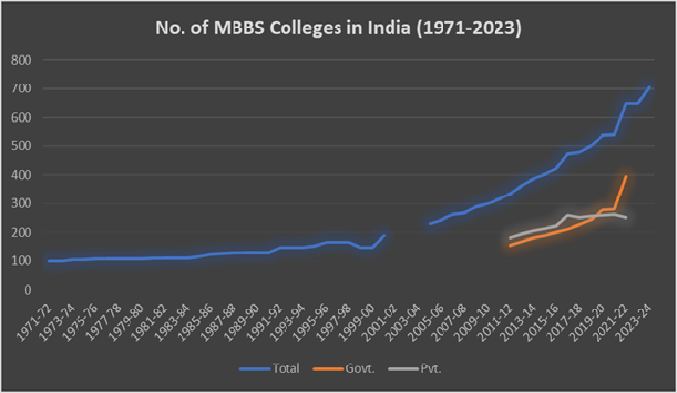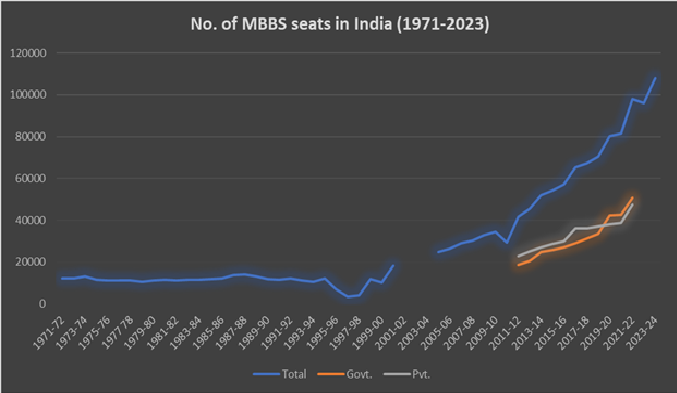Context
India has long struggled with healthcare disparities, particularly in rural areas, where a shortage of healthcare professionals has hindered access to medical attention. The historical dominance of private medical education has exacerbated this issue, contributing to an imbalance in the distribution of healthcare resources. However, recent years have witnessed a transformative shift, marked by a deliberate move towards public infrastructure creation.
Historical Context
The historical trajectory of medical education in India reveals a pattern of private sector dominance, especially since the 1980s. Private medical colleges proliferated, leading to an urban-centric concentration of healthcare professionals. The aspiration among medical graduates for lucrative opportunities in the private sector and abroad further exacerbated the shortage of healthcare workers in rural settings. The privatization of medical education introduced challenges such as high tuition fees, limiting accessibility for students from lower socio-economic backgrounds.
Global Mobility of Indian Medical Graduates
An intriguing phenomenon observed was the high migration rate of graduates from top-tier medical colleges, particularly towards developed countries, predominantly the United States. This trend underscored both the global mobility of Indian medical graduates and the challenges faced by India in retaining top medical talent. The lure of better prospects and advanced research opportunities abroad posed a significant challenge to the domestic healthcare system.
Evolution of Medical Colleges and Seats

An in-depth analysis of the growth of medical colleges in India reveals a gradual increase in numbers, particularly from the 2000s onwards. The surge in the 21st century, with the total number reaching 704 by 2023-24, reflects a commitment to addressing the physician-to-population ratio and improving healthcare delivery. Notably, the later part of this growth aligns with the government's efforts to enhance public healthcare infrastructure, with the number of public medical colleges surpassing private ones in 2019-20.

The trajectory of MBBS seats in India mirrors the growth in the number of colleges. The total MBBS seats increased from just over 12,000 in the early 1970s to an impressive count of 1,07,948 by 2023-24. The substantial expansion, particularly in the public sector, indicates a response to the growing population and the need to improve healthcare services, especially in rural areas.
Government Initiatives and Public Sector Growth
The turning point in this trajectory came with the government's renewed focus on strengthening public medical education infrastructure. The establishment of new government medical colleges and the expansion of existing ones have contributed significantly to the number of healthcare institutions in the country. Since 2014, 317 new public sector medical colleges have been established, marking a clear reversal of the policy shift in the 1980s.
The rapid expansion in the last decade, powered by public sector infrastructure, addresses the critical shortage of healthcare professionals. The increased number of seats, especially in the public sector, aims to ensure a more equitable distribution of healthcare resources across various regions, particularly in rural and underserved areas. Between 2020 and 2021 alone, the number of public sector medical colleges increased from 280 to 396.
Impact on Socio-economic Barriers
One of the most significant impacts of this public infrastructure expansion is the potential democratization of medical education. By making MBBS seats more accessible to a wider demographic, the government aims to reduce socio-economic barriers that have traditionally hindered equal access to medical education. This inclusivity is crucial for fostering a diverse medical workforce that reflects the varied needs of India's population.
Healthcare Delivery in Underserved Areas
The increased number of public medical colleges and seats has profound implications for healthcare delivery, particularly in rural and underserved areas. Graduates from public medical colleges are more likely to serve in these regions, addressing the acute shortage of healthcare professionals and improving the overall quality of healthcare services. This aligns with the government's goal of achieving universal health coverage and ensuring equitable healthcare for all.
The Way Forward
As India continues on this transformative trajectory, several key areas need comprehensive consideration:
● Curriculum Enhancement: The curriculum in medical education should be continually updated to align with global standards and emerging healthcare challenges. Incorporating technology, telemedicine, and interdisciplinary approaches can better prepare graduates for the evolving healthcare landscape.
● Research and Innovation: Encouraging research and innovation within the medical education framework is essential. Investing in state-of-the-art research facilities and fostering a culture of curiosity can contribute not only to academic excellence but also to advancements in healthcare practices.
● Public-Private Partnerships: Collaborations between public and private sectors can further enhance the quality and accessibility of medical education. Public-private partnerships can leverage the strengths of both sectors to create a more robust and sustainable healthcare ecosystem.
● Focus on Specialized Training: Beyond the MBBS degree, there should be a concerted effort to provide specialized training in areas such as primary care, preventive medicine, and public health. This will create a diverse cadre of healthcare professionals equipped to address the unique challenges of India's healthcare landscape.
● Community Engagement Programs: Integrating medical education with community engagement programs can foster a sense of social responsibility among medical students. Exposure to real-world healthcare challenges in diverse communities can instill empathy and a commitment to serving the broader population.
● Digital Education Platforms: Leveraging digital platforms for medical education can enhance accessibility, especially in remote areas. Online courses, virtual simulations, and telemedicine training can supplement traditional classroom teaching, ensuring a well-rounded education for all aspiring medical professionals.
Conclusion
The ongoing transformation of medical education in India signifies a monumental shift towards inclusivity and accessibility. The establishment of new government medical colleges and the increase in seats not only provide educational opportunities but also bring medical services closer to communities in need. As India addresses healthcare disparities through these initiatives, the comprehensive considerations for the way forward outlined above will contribute to shaping a more resilient, innovative, and accessible healthcare system for all its citizens. The democratization of medical education is not just a policy shift; it is a commitment to the well-being and development of the nation.
|
Probable Questions for UPSC Mains Exam
|
Source - The Hindu







